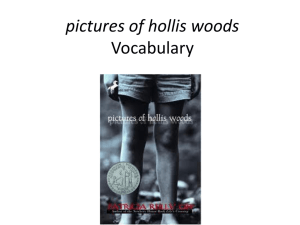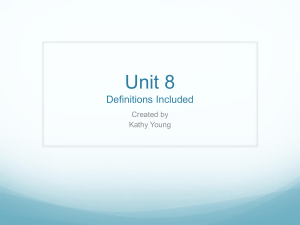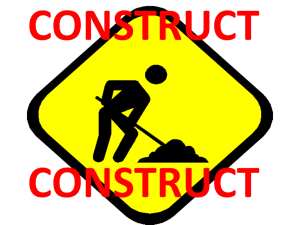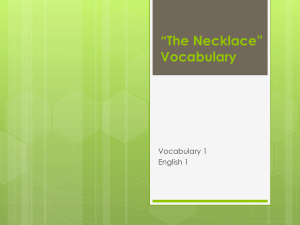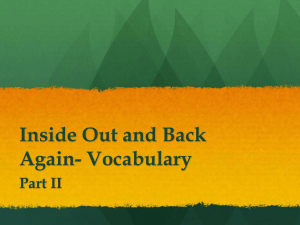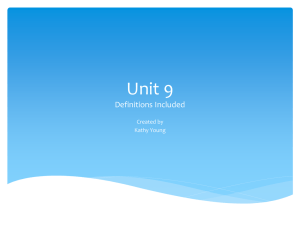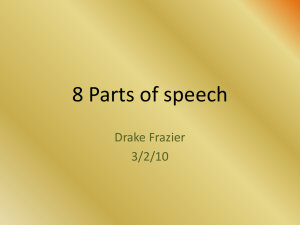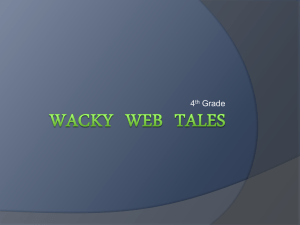Dee Gardner PPT - Brigham Young University
advertisement
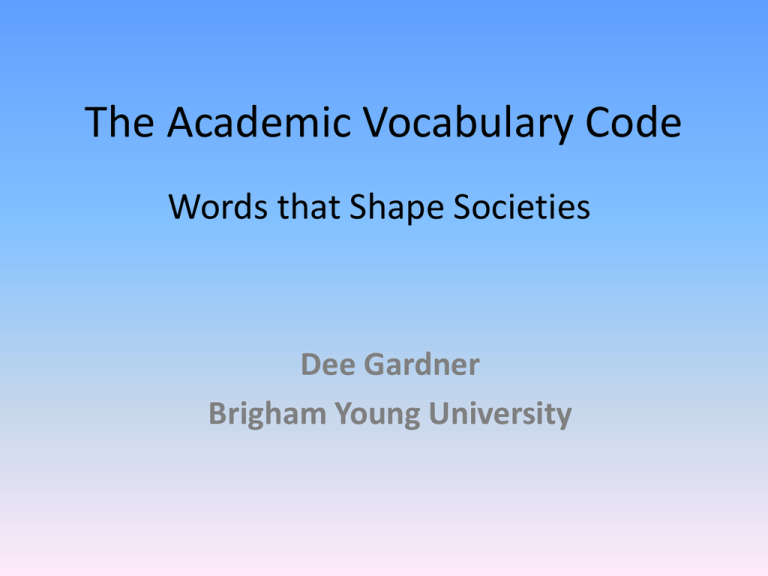
The Academic Vocabulary Code Words that Shape Societies Dee Gardner Brigham Young University USOE CRT PROFICIENCY RESULTS GRADE 4 2008 Science Math All Students 62% 75% Ethnicity Asian African American Caucasian Hispanic American Indian Pacific Islander 65% 39% 70% 31% 32% 41% 81% 51% 80% 53% 53% 67% ELL Non-ELL 21% 67% 45% 78% Migrant Non-Migrant 20% 63% 44% 75% Eco. Disadv Non-Eco Disadv 45% 73% 63% 82% Adapted from http://www.schools.utah.gov/assessment/documents/Results_CRT_Report_2008.pdf USOE CRT PROFICIENCY RESULTS GRADE 12 2008 Science Math All Students 55% 29% Ethnicity Asian African American Caucasian Hispanic American Indian Pacific Islander 59% 23% 62% 29% 20% 19% 29% 13% 35% 17% 20% 23% ELL Non-ELL 16% 57% 13% 31% Migrant Non-Migrant 14% 55% 10% 29% Eco. Disadv Non-Eco Disadv 38% 60% 27% 30% Based on 2007 National Assessment of Educational Progress (NAEP) Report (from Goldenberg, 2008) “…fourth-grade ELLs scored 36 points below non-ELLs in reading and 25 points below non-ELLs in math. The gaps among eighth-graders were even larger—42 points in reading and 37 points in math.” “Whatever the explanation for these achievement gaps, they bode ill for English learners’ future educational and vocational options.” “They also bode ill for society as a whole, since the costs of large-scale underachievement are very high.” Preventing The Fourth-Grade Slump “Students seem to need three kinds of strengths in order to progress to Stage 3 [Reading to Learn]: sufficient knowledge of the meanings of more academic and abstract words, sufficient reasoning ability to understand the more difficult texts, and facility with reading skills—word recognition, and decoding, and fluency.” (Chall, 2000) Academic Vocabulary Knowledge Academic Reading Skills Academic Success Economic Opportunity Societal Well-Being The Gate-keeping Tests of Education are Primarily Tests of Reading Ability By Extension, They are Also Tests of Robust Vocabulary Knowledge UBSCT ACT GRE SAT CRT LSAT GMAT MCAT UBSCT Sample Spiders Centipedes Sow Bugs. Spray webs and places where these pests crawl. Hit as many as possible. Repeat as necessary storage and disposal statement storage store in an area inaccessible to children and away from heat or open flame disposal this container may be recycled in the few but growing number of communities where aerosol can recycling is available before offering for recycling empty the can by using the product according to the label do not puncture if recycling is not available do not reuse empty container wrap the container and discard in the trash precautionary statements hazards to humans and domestic animals caution harmful if absorbed through the skin keep out of the reach of children avoid contact with skin eyes and clothing do not remain in enclosed areas after use ventilate enclosed areas before returning avoid contamination of food remove plants pets and birds before using cover and turn off fish aquariums wash hands thoroughly with soap and water after handling statement of practical treatment if on skin remove with soap and water if irritation persists seek medical attention environmental hazards do not apply directly to water this pesticide is toxic to fish Consider our English Language Learners’ Vocabulary Development with the End in Mind Academic Literacy “I am currently tutoring children in an orphanage in beautiful Nepal. The children go to a private English-medium school. One of the boys has been placed in remedial classes because of his math. Everyone has assumed that he is slow, but after I started tutoring him I realized that he has no idea what his teachers are saying in his math class (he has BICS, no CALP). I spent time tutoring him in English vocab for math (based on his textbook), and he can finally complete his math homework in less than 4 hours! Now I spend my time writing math-based English materials for him while he's at school. . . If more teachers understood these issues, a lot more ESL/EFL children would be able to succeed in school!” Rachel Wood (BYU TESOL MA Graduate) 95-98% Vocabulary Threshold for Basic Reading Comprehension When we are -------- -----, I ---- that your ---- of the ---------- ------ ------------- -------- will be -------* -------, ---------- with ------- to the -------------------------- between ------- --------- and ---------- ---------. 44% Word Knowledge When we are -------- today, I ---- that your ---- of the --------- facing -----language -------- will be ------forever, ---------- with ------- to the ---------- ------------between reading --------- and vocabulary ---------. 63% Word Knowledge When we are finished today, I hope that your view of the --------- facing second language learners will be changed forever, ---------- with ------to the ---------- relationship between reading abilities and vocabulary knowledge. 88% Word Knowledge When we are finished today, I hope that your view of the challenges facing second language learners will be changed forever, especially with regard to the ---------- relationship between reading abilities and vocabulary knowledge. 97% Word Knowledge Test Question: What kind of relationship exists between vocabulary knowledge and reading abilities? When we are finished today, I hope that your view of the challenges facing second language learners will be changed forever, especially with regard to the reciprocal relationship between reading abilities and vocabulary knowledge. 100% Word Knowledge Richard Anderson: “We found small but highly reliable increments in word knowledge attributable to reading at all grades and ability levels. The overall likelihood ranged from better than 1 in 10 when children were reading easy narratives [fiction] to near zero when they were reading difficult expositions.” (p. 61) Anderson, R. C. (1996). Research foundations to support wide reading. In V. Greaney (Ed.), Promoting reading in developing countries (pp. 55-77). Newark, Delaware:International Reading Association. Sample Fiction Text From A Wrinkle in Time Everybody was asleep. Everybody except Meg. Even Charles Wallace, the “dumb baby brother,” who had an uncanny way of knowing when she was awake and unhappy, and who would come so many nights tiptoeing up the attic stairs to her even Charles Wallace was asleep. How could they sleep? All day on the radio there had been hurricane warnings. How could they leave her up in the attic in the rickety brass bed, knowing that the roof might be blown right off the house and she tossed out into the wild night sky to land who knows where? Her shivering grew uncontrollable. You asked to have the attic bedroom, she told herself savagely. Mother let you have it because you are the oldest. Anglo-Saxon Words: 94.4% Greek-Latin Words: 5.6% Academic Word List: 0% Sample Science Text Source: CK-12 Foundation The early earth had no oceans and was frequently hit with meteorites and asteroids. There were also frequent volcanic eruptions. Volcanic eruptions released water vapor that eventually cooled to form the oceans. The atmosphere slowly became more oxygen rich as solar radiation split water molecules and cyanobacteria began the process of photosynthesis. Eventually the atmosphere became like it is today and rich in oxygen. The first complex organisms on earth first developed about 2 billion years ago. Anglo-Saxon Words: 75% Greek-Latin Words: 25% Academic Word List: 6.5% UBSCT Sample Spiders Centipedes Sow Bugs. Spray webs and places where these pests crawl. Hit as many as possible. Repeat as necessary storage and disposal statement storage store in an area inaccessible to children and away from heat or open flame disposal this container may be recycled in the few but growing number of communities where aerosol can recycling is available before offering for recycling empty the can by using the product according to the label do not puncture if recycling is not available do not reuse empty container wrap the container and discard in the trash precautionary statements hazards to humans and domestic animals caution harmful if absorbed through the skin keep out of the reach of children avoid contact with skin eyes and clothing do not remain in enclosed areas after use ventilate enclosed areas before returning avoid contamination of food remove plants pets and birds before using cover and turn off fish aquariums wash hands thoroughly with soap and water after handling statement of practical treatment if on skin remove with soap and water if irritation persists seek medical attention environmental hazards do not apply directly to water this pesticide is toxic to fish Anglo-Saxon Words: 68.3% Greek-Latin Words: 31.7% Academic Word List: 9.2% The number one problem for ELLs taking the UBSCT, CRT, and UALPA tests is VOCABULARY, in terms of both understanding the instructions and actually comprehending the content of the tests. From Personal Communication with Delia Allan (ELL Liaison and Test Proctor for Nebo School District) What to do? 1. We must care. 2. We must understand the nature of academic vocabulary: what it is, where it’s found, how it’s distinguished from other vocabulary, etc. 3. We must find ways to prioritize the instruction of academic vocabulary. Time is of the essence! 4. We must develop useful tools to aid academic learners and their teachers Finding the Academic Core University Word List (Xue & Nation, 1984) 1. Compiled from four small manually- assembled corpora 2. Resulted in 800 word families (covers 8.5% of academic texts) Academic Word List (Coxhead, 2000) 1. Compiled from a 3.5 million-word corpus 2. Four major registers (arts, commerce, law, science) 3. Approximately 875,000 words (tokens) each 4. Four major registers subdivided into 7 subject areas (28 total) 5. Words had to occur 100+ times in corpus 6. Words had to occur 10+ times in each of the four major registers 7. Words had to occur in 15 or more of the 28 subject areas 8. Resulted in 570 word families (covers 10% of the academic corpus) New Academic Core--First Iteration (Davies & Gardner, forthcoming) 1. Compiled from 425 million-word Corpus of Contemporary American English (COCA) 2. Nine major academic subregisters: Subregister Academic Magazine Newspaper TOTAL History 11,789,228 2,496,981 Education 8,453,127 Geog/SocSci 15,813,693 938,370 16,752,063 Law/PolSci 8,827,316 3,639,786 12,467,102 Humanities 11,110,772 Phil/Psych/Rel 6,659,684 5,803,787 12,463,471 Sci/Tech/Ag 13,389,027 9,414,505 22,803,532 Medicine 5,740,016 3,946,586 9,686,602 Financial 0 5,256,801 7,568,030 12,824,831 TOTAL 84,914,694 31,496,816 7,568,030 120,847,709 14,286,209 8,453,127 11,110,772 5. No assumptions about high-frequency words preceding academic core 6. Academic parameter set for PERC of 1.7 in COCA—means a word is 1.7 times as frequent in “academic” as we would expect, based on the fact that “academic” is one-fifth of COCA. 7. Julliand’s D (dispersion) in academic subregisters set for .854 or higher— means words must nicely distribute across the 9 academic subregisters. 8. To eliminate anomalies, words must appear at least 5 times in at least 8 of the 9 academic subregisters. 9. Resulted in 3,074 lemmas (covers 14.5% of the academic corpus) 10. Subsequently grouped into “optional” word families (600 word families) PERC 1.7 DISP .854 |----------- Academic Core----------------| the be and of a in to have to it that for with on do this they at but we his from that not by may such service power history low both market interest support site project cost energy available seek author focus upon concern central recognize particularly trade benefit between student group system program study provide political among however include community information social level such within result change research teacher education although policy process ---High Frequency Core--- advocate realm bias metaphor entity regulatory minimize necessity value prevention isolate assembly productive inventory dynamic equation offering content enroll abstract shared readily revolutionary circuit processing rethinking unsupported quantifiable higher-level blurring unrealized edited requisite quantitatively deletion traceable re-emergence proportionally subjectively dissociate interchangeably proximate chronologically class delineation self-defeating ubiquity requested vagueness catalyze astronomy biodiversity ozone self-efficacy asteroid modernity archaeology socialism liberalization stressor tariff sovereign bacterial infantry multilateral liturgy semiconductor pedagogical nation-state pixel sacrament mitigation polity self-concept depressive parotid tonsillectomy postoperatively sinusitis otolaryngology thrombosis histologic maxillary perfusion neoplasm randomised tibial turbinate pathologic squamous branchial otolaryngologist intraoperative mastoid tonsil sanitarian cholesteatoma haemoglobin sensorineural cutaneous -----------Academic Specialized--------- Lemma abstract abstract abstract abstraction academia academic academic develop developed developing development developmental developmentally ideal ideal idealism idealized ideally institute institute institution institutional institutionalization institutionalize institutionalized usable usage use useful usefully usefulness user POS Adjective Verb Noun Noun Noun Adjective Noun Verb Adjective Adjective Noun Adjective Adverb Adjective Noun Noun Adjective Adverb Noun Verb Noun Adjective Noun Verb Adjective Adjective Noun Noun Adjective Adverb Noun Noun ACAD FREQ 4,681 456 628 1,413 812 23,437 2,239 55,517 3,647 9,421 67,157 5,775 584 6,350 3,988 661 531 1,410 13,797 1,282 29,476 9,291 544 957 566 780 2,569 67,106 12,158 264 1,290 15,641 Word-Family Possibilities accept (v), acceptance (n), acceptable (j), accepted (j), unacceptable (j), acceptability (n), unacceptably (r), acceptably (r), acceptor (n), unacceptability (n) human (j), human (n), humanity (n), humanist (n), humanist (j), humanism (n), humanistic (j), inhuman (j), humanly (r), inhumanity (n), humanness (n) Heavily Academic Word-Families structure (n), structural (j), structure (v), structured (j), restructuring (n), restructure (v), structuring (n), structurally (r), unstructured (j), structuralist (j), structuralism (n), restructured (j) modern (j), modernity (n), postmodern (j), modernization (n), modernist (j), modernism (n), postmodernism (n), modernize (v), postmodernist (j), modernist (n), modern (n), modernized (j), modernizing (j), modernizer (n), modernizing (n), postmodern (n) Screenshot of Word and Phrase – Showing Academic Word Functionality Screenshot of Word and Phrase – Showing Synonyms in Phrases Screenshot of Word and Phrase – Showing Part of Speech Collocates The Academic Vocabulary Code Words that Shape Societies Dee Gardner Brigham Young University
